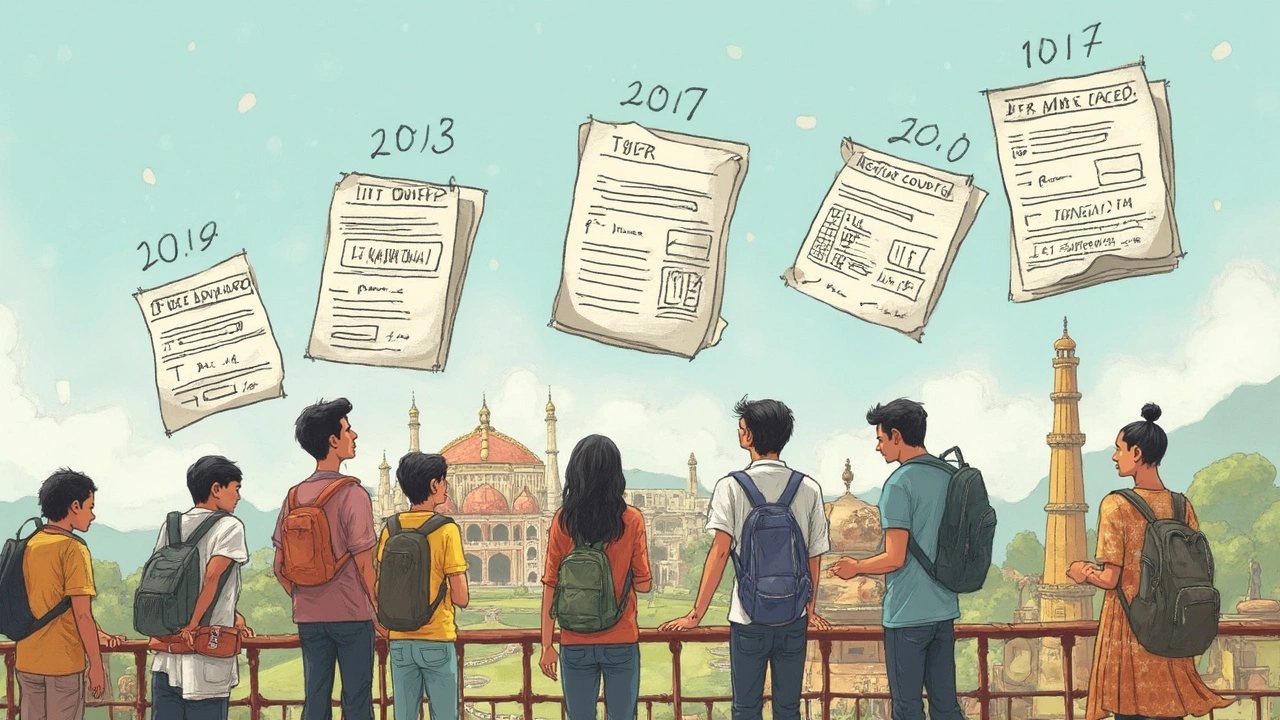Ever heard folks say, "When IIT X sets the paper, it goes easy on you"? It sounds comforting, but the truth is a bit messier. If you’re trying to figure out which IIT made the easiest JEE Advanced paper, you’re definitely not the first—loads of students hunt for patterns hoping for a lucky break.
The thing is, JEE Advanced isn’t a regular school test. Every year, a different IIT takes charge of preparing the paper, and the buzz starts: Will this year be brutal? Or will it actually be a breeze? Stories and rumors fly everywhere, and sometimes you’ll see memes floating around after exam day calling the paper a nightmare or a walk in the park.
This obsession with identifying the 'easiest' year or the 'lenient' IIT comes up because, well, nobody trusts surprises here. But does the IIT actually make a real difference? And have there actually been years where the paper felt genuinely easier?
- How the JEE Advanced Paper Is Set
- Breaking Down 'Easy' vs. 'Tough'
- When Did Students Face an 'Easy' Paper?
- Does the IIT Setting the Paper Matter?
- Prep Tips: Why You Can't Bank on Luck
How the JEE Advanced Paper Is Set
Most people just assume every JEE Advanced paper is whipped up in some secret lab, but here’s what actually happens. Each year, one of the old IITs—think IIT Bombay, IIT Delhi, IIT Kanpur, IIT Kharagpur, IIT Madras, IIT Guwahati, or IIT Roorkee—takes turns leading the paper-setting process. This is not a one-man show. Usually, there’s a big team called the Organizing Institute. They don’t just handpick tricky questions on a whim.
Here’s a quick look at how things go down:
- The Organizing Institute forms different Question Paper Committees, with professors from various IITs coming together.
- Questions are brainstormed, discussed, and written. Some are brand new, others are tweaked versions of past favorites or totally fresh concepts.
- Questions go through tests for errors, ambiguity, and difficulty. There are review rounds, sometimes involving mock students to spot anything unclear.
- Everything happens under tight security—no leaks are tolerated. Only a handful of core members know the final version until D-day.
The paper always hits Maths, Physics, and Chemistry. The balance changes, but the focus stays on basics and logical thinking—no trick questions designed just to waste your time.
| Year | Lead IIT (Organizing) |
|---|---|
| 2024 | IIT Madras |
| 2023 | IIT Guwahati |
| 2022 | IIT Bombay |
| 2021 | IIT Kharagpur |
| 2020 | IIT Delhi |
The whole idea is to make sure the JEE Advanced paper is fair, unpredictable, and safe from leaks. No single person—even from the Organizing IIT—decides how "easy" or "hard" the test will be. Teamwork and secrecy rule here, and checks at every step keep things pretty balanced.
Breaking Down 'Easy' vs. 'Tough'
First things first: what even makes a JEE Advanced paper 'easy' or 'tough'? Most students focus on how many straightforward questions pop up, the length of calculations, and the number of crazy twists in the problems. But the line between easy and tough isn’t always clear because what feels simple to one person could be a nightmare for someone else. Instead of just trusting your gut, let's look at some solid facts and trends.
Year after year, the authorities point out that their aim is not to trick you, but to test how well you understand concepts. Some years, though, the paper ends up with more direct questions—less calculation-heavy or fewer multi-step reasoning problems. Other years look like they want to test if you can survive a brain marathon.
One way of checking how 'easy' a paper was is looking at the qualifying cutoff. Higher cutoffs usually mean the paper was less challenging for most. Here’s a quick summary from past years for reference:
| Year | IIT Paper Setter | Overall Cutoff (%) | Student Buzz |
|---|---|---|---|
| 2016 | IIT Guwahati | 20.1 | Brutal, tough math! |
| 2018 | IIT Kanpur | 25.5 | Balanced, but physics tricky |
| 2020 | IIT Delhi | 28.7 | Many called it easier than usual |
| 2021 | IIT Kharagpur | 30.6 | Paper felt very doable |
| 2023 | IIT Guwahati | 23.0 | Mixed reviews, not so tough |
So, looking at these numbers, 2021 (IIT Kharagpur) stands out for a higher cutoff. Many students actually finished with time left and said several questions felt straight out of NCERT. On the other hand, 2016 is remembered as a nightmare, especially in maths, with a lower cutoff reflecting the pain.
To sum up:
- ‘Easy’ usually means more direct questions, familiar patterns, and fewer traps.
- ‘Tough’ includes unexpected twists, heavy calculations, and questions that test how calm you stay under stress.
- The qualifying cutoff tells you if others found it easy too, not just you!
Of course, the real challenge is, the JEE Advanced is designed to surprise you. Even in the so-called easy years, the exam rewards those who prepare for anything, not just hope for a lucky year.

When Did Students Face an 'Easy' Paper?
Everyone wants to know—was there ever a year when the JEE Advanced paper felt easy? If you go by student chatter and reactions online, a few years pulled up surprisingly high scores, which usually hints that the paper was less of a monster than usual.
Take 2012. That year, IIT Delhi set the paper, and students called it "doable" compared to previous years. There were fewer trick questions, and most problems stuck closer to NCERT concepts. In fact, the average score jumped. Fast forward to 2016, when IIT Guwahati was in charge—students again found the paper straightforward, especially in Maths, which is usually a pain point.
Here’s what happened in a few stand-out years:
| Year | Paper-Setting IIT | Average % Score (approx.) | Student Response |
|---|---|---|---|
| 2012 | IIT Delhi | 35% | Relatively easier, direct questions |
| 2016 | IIT Guwahati | 30% | Straightforward, higher cut-offs |
| 2018 | IIT Kanpur | 28% | Many found Maths easier, Chemistry harder |
For 2020, set by IIT Delhi again, some students said the Physics section was easier than expected, but rising competition and shifting cut-offs kept things tough overall.
Don’t just take my word for it. Check out what experts said after 2016:
"The paper avoided unnecessary confusion. Concept-based problems dominated, making it friendlier for hardworking students rather than just the quickest ones."
— Rajeev Pandey, JEE Mentor, Career Launcher
That said, "easy" is super relative. What feels like a cakewalk to one topper could trip up someone else. But when you see higher average marks and more qualifying candidates, you know most of the batch felt the paper was on the lighter side.
Does the IIT Setting the Paper Matter?
Here's the question everyone debates: does it really make a difference which IIT makes the JEE Advanced paper? At first glance, you might think yes—each IIT has a reputation. For instance, people joke that IIT Kanpur goes heavy on Math, while IIT Madras loves concepts. But the real deal is, there’s a central JEE Advanced committee made up of faculty from all major IITs. Even if IIT Bombay or IIT Delhi leads in a certain year, no single group gets total control. Everything, right from paper design to question moderation, is double-checked and has to stick to strict guidelines.
Let’s look at some actual data. Here’s a table showing the lead organizing IIT and the average student response about paper difficulty in recent years (based on student polls and online forums):
| Year | Organizing IIT | Paper Perception |
|---|---|---|
| 2024 | IIT Madras | Moderate, some easy Physics |
| 2023 | IIT Guwahati | Tough, lengthy Paper 2 |
| 2022 | IIT Bombay | Challenging, especially Chemistry |
| 2021 | IIT Kharagpur | Balanced, standard difficulty |
| 2020 | IIT Delhi | Moderate, easy Math section |
If you look at the numbers, you’ll see no fixed trend. One year the paper feels easy, the next year, the same IIT stuns everyone. That’s mostly because the exam is designed to avoid patterns or leaks. Every IIT has to make sure the paper checks off core concepts, mix of questions, and fair marking schemes. It's not just one or two professors making decisions.
To drive this home, here’s why the organizing IIT hardly impacts the JEE Advanced level:
- The question paper is developed by a team, not by one person or even one department.
- There’s a standard protocol for vetting and testing every question.
- Any bias or accidental pattern is double-checked by professors from other IITs.
- The final version is reviewed at multiple levels before it’s used.
So, if you’re hoping the organizing IIT will give you a 'lucky' paper, don’t count on it. Prep for the unpredictable. No single IIT can guarantee an easier ride.

Prep Tips: Why You Can't Bank on Luck
Relying on the paper being “easy” is probably the riskiest move you can make in your JEE Advanced journey. Even if you scan through stories of certain years feeling ‘lighter,’ it’s always a mixed bag—what’s easy for one, might be weirdly tricky for another. Also, you never get to see the paper until the day you enter the hall. No leaks, no guesses. Every IIT tries to do something surprising to keep things fair and challenging.
Let’s look at some real numbers. Check out this table of the overall average scores and cutoff marks from the past five years. Notice how the scores bounce up and down, regardless of which IIT set the paper:
| Year | IIT Setting Paper | Average Score (%) | General Category Cutoff (Total) |
|---|---|---|---|
| 2024 | IIT Madras | 31% | 109/360 |
| 2023 | IIT Guwahati | 28% | 93/360 |
| 2022 | IIT Bombay | 29% | 104/360 |
| 2021 | IIT Kharagpur | 30% | 126/360 |
| 2020 | IIT Delhi | 27% | 90/396 |
See how unpredictable it is? Even when scores look higher or lower, it rarely lines up perfectly with popular assumptions about a "lenient" IIT.
So, how do you prep smart?
- Don't skip topics thinking they'll never ask them—JEE loves surprise questions, including old favorites and the rarely-touched stuff.
- Papers often test how well you understand concepts and connect topics, not just how much you crammed.
- Treat every mock as if it's the real deal—time yourself, use an OMR sheet, and sit in a quiet place, just like on D-day.
- After every practice test, go through your mistakes. Make a simple list of errors. This shows you exactly where you mess up again and again—and lets you fix it before the real test.
- If one subject feels tougher, don’t avoid it. Consistent small efforts add up. 20 minutes daily beats one massive, overwhelming study session.
No magic hacks, no shortcut IIT-based predictions work better than basic, honest prep. Luck helps only if you’re ready—even if the actual paper is a curveball, it won’t shake you up if you’re well-practiced and adaptable.




